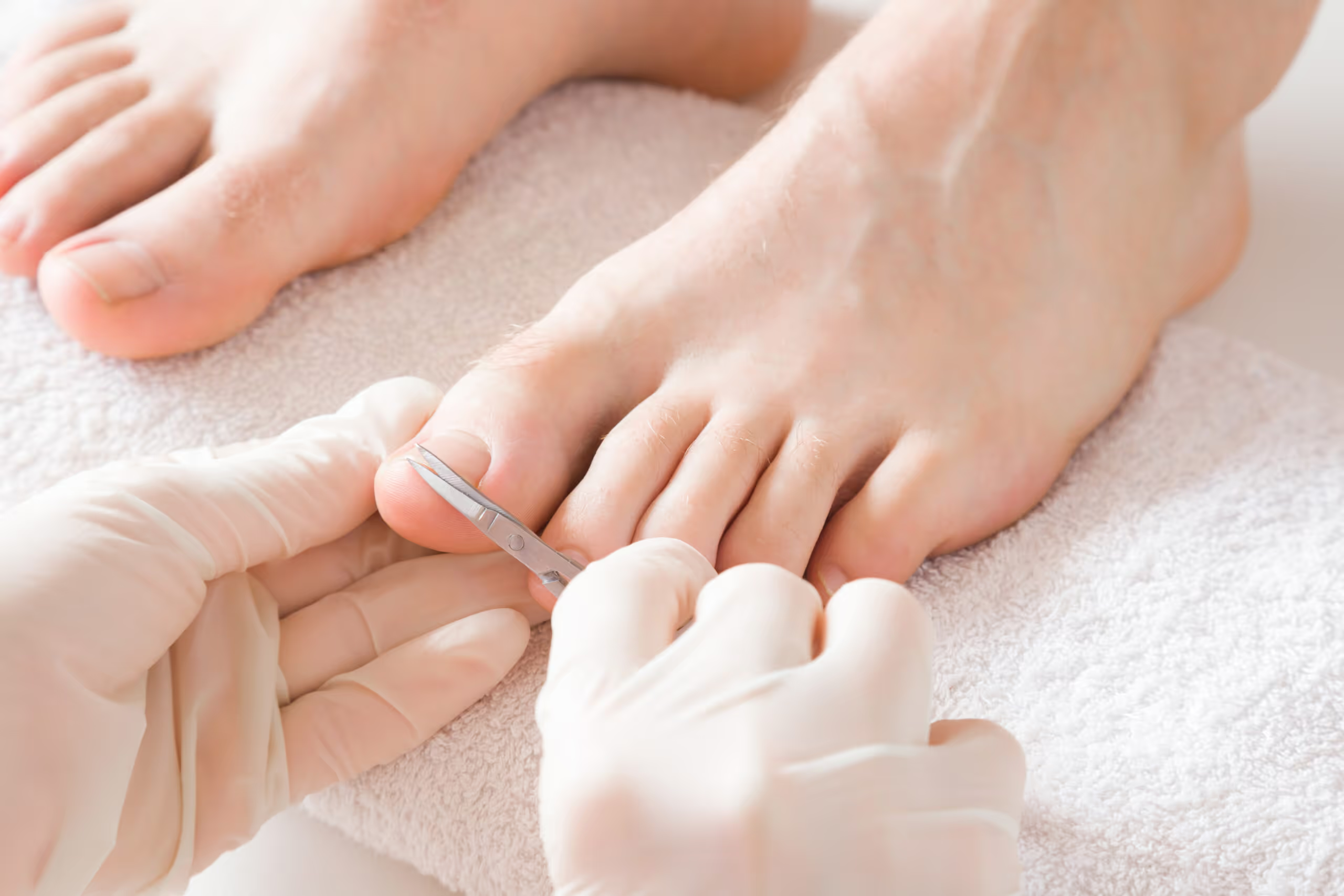เลือกหัวข้อที่อ่าน
- สาเหตุที่คนไข้โรคเบาหวานเกิดแผลที่เท้าได้ง่าย
- วิธีการดูแลเท้าของผู้ป่วยโรคเบาหวาน
- พฤติกรรมที่ควรหลีกเลี่ยง
- ขั้นตอนในการให้บริการเรื่องการตัดเล็บเท้า
- ทำแบบประเมินความเสี่ยง
การดูแลเท้าและเล็บเท้าในคนไข้เบาหวาน
ถ้าการตัดเล็บเท้าไม่ถูกวิธีหรือการดูแลเท้าได้ไม่ดี โดยเฉพาะในคนไข้เบาหวาน อาจเป็นสาเหตุใหญ่ของการตัดนิ้วหรือตัดเท้าได้ในอนาคต การดูแลและให้ความรู้เรื่องเล็บเท้าอย่างถูกวิธีจะช่วยปัองกันได้ในระดับหนึ่งไม่ให้เกิดบาดแผลจากภาวะแทรกซ้อน อาการเจ็บปวด มีปัญหาเวลาเดิน การดูแลเรื่องเล็บขบที่เกิดจากการตัดเล็บไม่ถูกวิธีก็เช่นกัน
สาเหตุที่คนไข้โรคเบาหวานเกิดแผลที่เท้าได้ง่าย
เกิดจากเส้นประสาทส่วนปลายเสื่อม ส่งผลให้ผิวหนังบริเวณส่วนขาแห้งและมีอาการคัน ทำให้คนไข้ต้องเกาและส่งผลให้แผลแตกและเกิดการติดเชื้อได้ง่าย อีกกรณีหนึ่งคือเมื่อคนไข้มีความรู้สึกที่เท้าลดลงขณะเดินก็จะเกิดบาดแผลได้ง่าย กว่าจะรู้ตัวแผลอาจเกิดการติดเชื้อและลุกลามแล้วทำให้ยากต่อการรักษา ในกรณีรุนแรงอาจถึงกับต้องตัดขาในคนไข้บางราย
วิธีการดูแลเท้าของผู้ป่วยโรคเบาหวาน
- ล้างเท้าด้วยน้ำธรรมดาและสบู่ที่อ่อนโยนต่อผิวทุกวันหลังจากอาบน้ำ ไม่แนะนำให้ใช้แปรงขนแข็งขัดเท้า
- ทำการซับเท้าให้แห้งโดยเฉพาะบริเวณซอกนิ้วเท้า ด้วยผ้าที่สะอาดและนุ่ม เช่น ผ้าขนหนู เป็นต้น
- ตรวจดูเท้าทุกวันและสังเกตว่ามีอาการผิดปกติไหม เช่น ปวด บวม มีแผล รอยช้ำ ผิวเปลี่ยนสี หรือเม็ดพอง เป็นต้น ควรตรวจให้ทั่วทั้งฝ่าเท้า ส้นเท้า (สามารถใช้กระจกส่องหากมองไม่เห็น) รวมถึงซอกระหว่างนิ้วและรอบเล็บเท้า หากพบความผิดปกติควรรีบปรึกษาแพทย์
- แนะนำให้สวมรองเท้าตลอดเวลาทั้งในและนอกบ้าน เนื่องจากการสวมรองเท้าจะช่วยป้องกันการเกิดแผล และควรตรวจสอบด้านในรองเท้าหาสิ่งแปลกปลอมที่อาจส่งผลให้เกิดแผลได้ เช่น กรวด ทราย ก่อนสวมรองเท้าทุกครั้ง การเกิดแผลถึงแม้จะมีขนาดที่เล็กมากหรือเกิดรอยถลอกจากการถูกของแข็ง ก็อาจส่งผลให้เกิดแผลที่จะหายช้า
- รองเท้าที่สวมใส่ควรถูกสุขลักษณะ ควรมีพื้นผิวที่นิ่ม มีขนาดพอดี ไม่คับหรือหลวมจนเกินไป เพราะจะทำให้เกิดการเสียดสีและกลายเป็นแผลในที่สุด
- ควรทำการตัดเล็บเท้าด้วยความระมัดระวัง และควรตัดเล็บเท้าด้วยการตัดขวางเป็นเส้นตรงให้พอดีกับเนื้อ หากผู้ป่วยมีปัญหาด้านสายตา ควรให้ผู้อื่นช่วยตัดเล็บให้
- ควรทาโลชั่นที่เท้า เพราะจะช่วยลดความแห้งแข็งของผิวหนัง แต่ควรหลีกเลี่ยงการทาระหว่างซอกนิ้วเท้า
- การออกกำลังบริเวณขาและเท้าอย่างสม่ำเสมอ อย่างน้อยวันละ 15 นาที เป็นสิ่งที่ควรทำ เพราะจะช่วยให้เกิดการไหลเวียนของเลือดที่ดีขึ้น
- ไม่ควรตัดเล็บเท้าเองหากมีผิวหนังที่หนา หรือมีตาปลา ควรให้ผู้ชำนาญการตัดเล็บเท้าให้บางและตัดทุก 6-8 สัปดาห์
- หากเกิดบาดแผล จำเป็นต้องได้รับการรักษาโดยเร็ว
| ก่อนทำ | หลังทำ |
พฤติกรรมที่ควรหลีกเลี่ยง
- ควรหลีกเลี่ยงการสวมรองเท้าปลายแหลม ส้นสูง มีรูเปิด ไม่มีสายรัด หรือไม่หุ้มส้นด้านหลัง
- ไม่ควรสวมถุงเท้าที่รัดแน่นจนเกินไป
- ไม่ควรใช้กระเป๋าน้ำร้อน หรือเครื่องทำความร้อนประคบหรือเป่าที่เท้า
- ควรหลีกเลี่ยงการเดินด้วยเท้าเปล่า โดยเฉพาะการเดินบนทางเดินที่มีอุณหภูมิร้อนจัด แต่หากไม่สามารถหลีกเลี่ยงได้ ควรทำการเดินอย่างระมัดระวัง
- ควรหลีกเลี่ยงการใช้ยาทาตาปลา ยาจี้หูด หรือมีดโกนกับเท้าด้วยตนเอง ควรทำการปรึกษาแพทย์ก่อนทุกครั้ง
- แนะให้ลดหรือควบคุมน้ำหนักไม่ให้มากเกินเกณฑ์
- งดสูบบุหรี่ เพราะสารในบุหรี่จะส่งผลให้หลอดเลือดตีบ และทำให้การไหลเวียนของเลือดไปที่เท้าได้น้อยลง
- ไม่ควรสวมเครื่องประดับที่เท้า
ขั้นตอนในการให้บริการเรื่องการตัดเล็บเท้า
- ประเมินสภาพและปัญหาเท้า เล็บเท้า เล็บมือของคนไข้เบาหวาน และผู้รับบริการอื่นที่เข้ารับบริการ
- แจ้งแนวทางการรักษาตามแผนการรักษา ระยะเวลา และประเมินค่ารักษา
- เตรียมอุปกรณ์สำหรับตัดเล็บ
- ทำความสะอาดเล็บและเท้าด้วยน้ำเกลือ 0.9%NSS ก่อนทำและหลังทำหัตถการ
- ตัดเล็บในลักษณะแนวตรงถูกวิธี และขูดทำความสะอาดผิวบริเวณที่มีเชื้อรา
- ภายหลังตัดเล็บเสร็จทำความสะอาดเล็บและเท้า ฝ่าเท้าอีกครั้ง พร้อมทั้งตรวจดูบริเวณซอกนิ้วเท้า ฝ่าเท้า หลังเท้าให้อยู่ในสภาพปกติ
- ทาครีมโลชั่นบริเวณเท้าให้ทั่ว โดยไม่ทาบริเวณซอกนิ้ว
- แนะนำคนไข้และญาติถึงวิธีการดูแลและตัดเล็บให้ถูกวิธี

การประเมินหลังการทำหัตถการ
ผู้ป่วยได้รับการตัดเล็บอย่างถูกวิธี สะอาด เรียบร้อย และไม่พบภาวะแทรกซ้อนหลังทำหัตการ เช่น เลือดออกหรือบาดแผล ในการตัดเล็บเท้า จำเป็นต้องมีคำสั่งจากแพทย์ และถ้าพบปัญหาเรื่องเท้าหรือเล็บเท้าที่นอกเหนือจากการบริการของเราแล้ว จะมีการแจ้งแพทย์ทุกครั้ง เพื่อทำการส่งต่อให้แพทย์เฉพาะทางทำการรักษาต่อไป
โรงพยาบาลเมดพาร์ค เปิดให้บริการทำและดูแลเล็บเท้าในคนไข้กลุ่มเบาหวาน
ทุกวันอังคาร - วันเสาร์ เวลา 08.00-18.00 น. โดยพยาบาลผู้เชี่ยวชาญด้านเล็บเท้า (Podiatry) และมีประสบการณ์เฉพาะทางเกี่ยวกับเล็บเท้า การดูแลผู้ป่วยเบาหวานที่มีปัญหาเรื่องเล็บเท้า ผู้ป่วยที่อยู่ระหว่างการให้ยาเคมีบำบัด ยาละลายลิ่มเลือด และผู้ป่วยหรือบุคคลทั่วไปที่มีปัญหาเกี่ยวกับเล็บเท้า หนังแข็ง เล็บขบ เล็บเชื้อรา เป็นต้น
คุณมีความเสี่ยงเป็นโรคเบาหวานชนิดที่ 2 หรือไม่?
ลองทำแบบประเมินเลย










